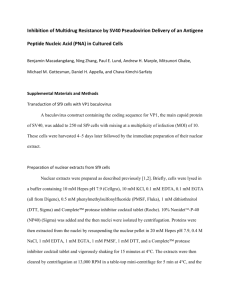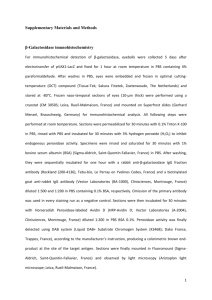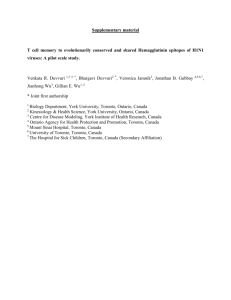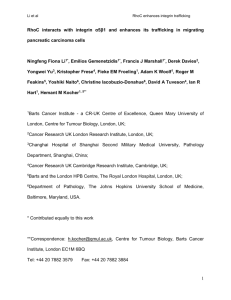Supplementary Information (doc 53K)
advertisement
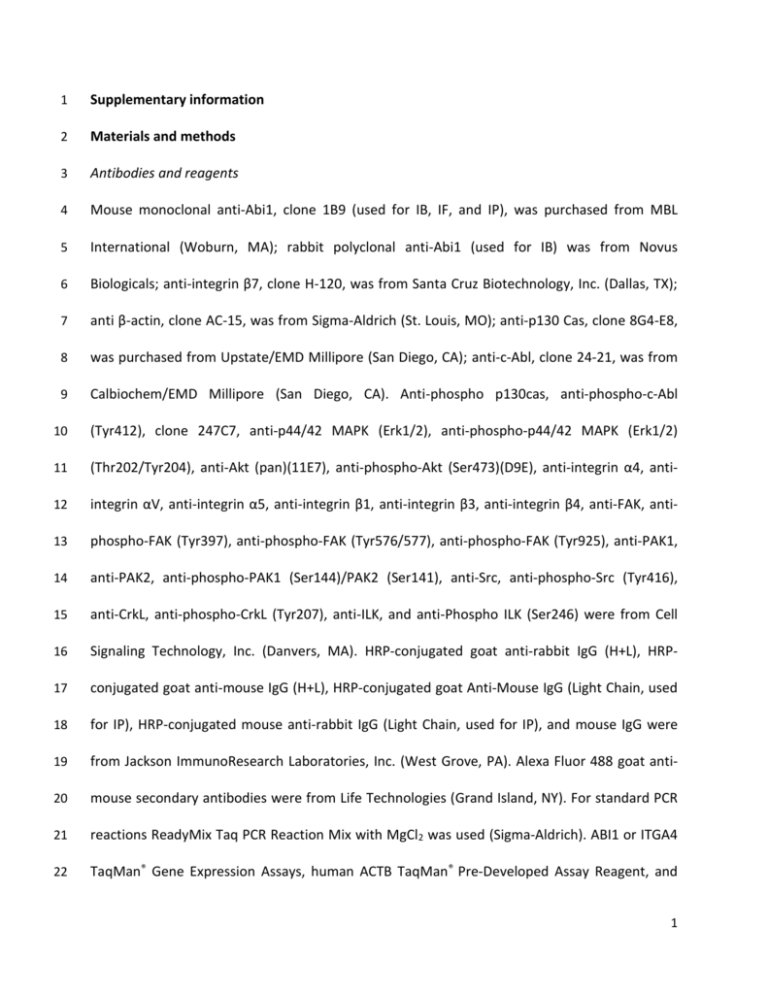
1 Supplementary information 2 Materials and methods 3 Antibodies and reagents 4 Mouse monoclonal anti-Abi1, clone 1B9 (used for IB, IF, and IP), was purchased from MBL 5 International (Woburn, MA); rabbit polyclonal anti-Abi1 (used for IB) was from Novus 6 Biologicals; anti-integrin β7, clone H-120, was from Santa Cruz Biotechnology, Inc. (Dallas, TX); 7 anti β-actin, clone AC-15, was from Sigma-Aldrich (St. Louis, MO); anti-p130 Cas, clone 8G4-E8, 8 was purchased from Upstate/EMD Millipore (San Diego, CA); anti-c-Abl, clone 24-21, was from 9 Calbiochem/EMD Millipore (San Diego, CA). Anti-phospho p130cas, anti-phospho-c-Abl 10 (Tyr412), clone 247C7, anti-p44/42 MAPK (Erk1/2), anti-phospho-p44/42 MAPK (Erk1/2) 11 (Thr202/Tyr204), anti-Akt (pan)(11E7), anti-phospho-Akt (Ser473)(D9E), anti-integrin α4, anti- 12 integrin αV, anti-integrin α5, anti-integrin β1, anti-integrin β3, anti-integrin β4, anti-FAK, anti- 13 phospho-FAK (Tyr397), anti-phospho-FAK (Tyr576/577), anti-phospho-FAK (Tyr925), anti-PAK1, 14 anti-PAK2, anti-phospho-PAK1 (Ser144)/PAK2 (Ser141), anti-Src, anti-phospho-Src (Tyr416), 15 anti-CrkL, anti-phospho-CrkL (Tyr207), anti-ILK, and anti-Phospho ILK (Ser246) were from Cell 16 Signaling Technology, Inc. (Danvers, MA). HRP-conjugated goat anti-rabbit IgG (H+L), HRP- 17 conjugated goat anti-mouse IgG (H+L), HRP-conjugated goat Anti-Mouse IgG (Light Chain, used 18 for IP), HRP-conjugated mouse anti-rabbit IgG (Light Chain, used for IP), and mouse IgG were 19 from Jackson ImmunoResearch Laboratories, Inc. (West Grove, PA). Alexa Fluor 488 goat anti- 20 mouse secondary antibodies were from Life Technologies (Grand Island, NY). For standard PCR 21 reactions ReadyMix Taq PCR Reaction Mix with MgCl2 was used (Sigma-Aldrich). ABI1 or ITGA4 22 TaqMan® Gene Expression Assays, human ACTB TaqMan® Pre-Developed Assay Reagent, and 1 23 TaqMan® Gene Expression Master Mix were purchased from Life Technologies (Grand Island, 24 NY). For CD34+ enrichment, CD34 MicroBead Kit and MACS® Separation LS Columns (Miltenyi 25 Biotec Inc., Auburn, CA) were used. Mounting medium Vectashield with DAPI was purchased 26 from Vector Laboratories, Inc. (Burlingame, CA). Anti-mouse CD49d/VLA-4-FITC was from 27 Southern Biotech (Birmingham, AL). Anti-human CD49d/VLA-4-APC was purchased from 28 BioLegend (San Diego, CA). 29 30 Quantitative transcription analysis with real time polymerase chain reaction (qRT-PCR) 31 Total mRNA was purified using PureLink RNA Mini Kit from Ambion/Life Technologies according 32 to the manufacturer’s protocol. SuperScript First-Strand Synthesis System (Life Technologies) 33 was used for reverse transcription according to the manufacturer’s protocol, and relative levels 34 of RNA were measured by quantitative real-time PCR using the ABI PRISM 7000 Sequence 35 Detection System (Applied Biosystems, Foster City, CA). ABI1, ITGA4, and ACTB were amplified 36 using either SYBR Green Master Mix and gene specific primers or taqman Universal Master Mix 37 (Applied Biosystems) and gene specific TaqMan probes (for details see Supplementary Tables 1 38 and 2, and Suppl. Fig. 7). Cycle threshold (ct) values of individual genes were subtracted from Ct 39 values for actin (ΔCt), and were then used to calculate fold change in relative gene expression 40 (2–ΔΔCT). For standard PCR reactions, ReadyMix Taq PCR Reaction Mix with MgCl 2 (Sigma- 41 Aldrich) was used. Gene expression analysis for cyclin, cyclin kinases, and inhibitors were 42 performed using PrimePCR Custom Plate 96 Well and iTaqTM Universal SYBR® Green Supermix 43 (Bio-Rad). PrimePCR Assay reactions were performed on a C1000TM Thermal Cycler with 44 CFX96TM Real-Time System using the BioRad gene expression assay protocol. Results were 2 45 evaluated using Bio-Rad CFX manager. Human miR-181a, miR-181a-2*, RNU19, and RNU6B 46 were amplified using TaqMan Universal PCR Master Mix (Applied Biosystems by Life 47 Technologies) and miR specific TaqMan probes (Supplementary Table 2). Relative quantitation 48 of gene expression was evaluated by real-time PCR using two independent systems: CFX96 TM 49 Real-Time System (Bio-Rad) and ViiA™ 7 Real-Time PCR System (Applied Biosystems/Life 50 Technologies). 51 52 Immunoblotting 53 Cells were lysed in LDS Sample Buffer (Life Technologies), reduced for 5 minutes, frozen for 2 h, 54 thawed, and incubated in the presence of Benzonase Nuclease (Novagene/EMD Millipore, San 55 Diego, CA). Samples were sonicated for 18 minutes followed by a final 5 min reduction at 70°C 56 and then evaluated by Western Blotting. Equal loading was ensured by lysing the same number 57 of cells, and was further determined by Coomassie blue staining. After transfer, membranes 58 were blocked for 2 h at RT or overnight at +4°C in 5% milk or 3% BSA (phospho-signal) in TBST 59 buffer. Membranes were incubated with primary antibodies in 2% milk or BSA for 2 h, washed 60 (4x), incubated with secondary antibodies for 1 h, and washed (4x). Chemiluminescent signal 61 was obtained using SuperSignal West Pico Substrate (Thermo Scientific, Rockford, IL) and 62 Konica Minolta SRX-101A developer. 63 64 Affymetrix miRNA arrays 65 Small RNA was labeled using the Flash-tag labeling Kit from Affymetrix (Santa Clara, CA). 66 Labeled miRNAs were run on an RNA6000 Bioanalyzer chip to verify equimolar concentration of 3 67 small RNAs in all samples prior to adding RNA to the hybridization cocktail. Small RNAs were 68 hybridized for 17 h at 48°C, 60 rpm to Affymetrix miRNA v3.0 arrays. Affymetrix Wash/Stain Kit 69 was used to stain hybridized RNA. Non-specifically bound RNA was removed using the 70 Affymetrix FS450 Fluidics Station and wash/stain protocol FS450_0002. RNA was visualized 71 using an Affymetrix 3000 7G scanner. Partek Genomics Suite version 6.6 was used to assess the 72 quality of the arrays and to detect differentially expressed genes. To this end RMA was 73 employed and only genes in the resulting ANOVA file which were at least 2 fold up- or down- 74 regulated and had an unadjusted p-value of ≤ 0.05 were included. 75 76 Transfection 77 K562cII or K562-STI-R cells were transiently transfected with the Abi1 silencing pGFP-V-RS 78 vector encoding a 29 mer shRNA (OriGene Technologies, Inc.) or Abi1-YFP (a kind gift from Dr. 79 Ann M. Pendergast). Lipofectamine 2000 was used as a transfecting agent. Transfection 80 efficiency was determined to be 20-25% for both Abi1 overexpressing or silencing vectors. 81 82 Engraftment of human cells in immunodeficient mice 83 K562 cells were transfected with vector encoding YFP tagged Abi1. Lipofectamine 2000 was 84 used for the experiment (Life Technologies) in accordance to manufacturer’s instructions. 85 Transfection efficiency was 24%. Control (K562cI) or Abi1 overexpressing cells (K562cI/Abi1) 86 were harvested and transplanted via tail vein injection (2x106 cells/mouse) into 12 week old 87 sub-lethally irradiated (3.8 Gy) NSG mice (NOD.Cg-Prkdcscid Il2rgtm1Wjl/SzJ, Jackson Laboratory, 88 Bar Harbor, ME, stock#005557). Mice were euthanized after 4 weeks, and marrow contents of 4 89 femurs as well as spleens, livers, and tumors were obtained and subjected to pathological 90 evaluation. Leukemic cell engraftment was assessed by FISH. BCR-ABL protein levels in marrow 91 cells obtained from mice were evaluated by immunoblotting. 92 93 Confocal microscopy 94 Cytospins were prepared in a Cytospin centrifuge (Shandon Cytospin 3). Cells were fixed for 20 95 min in 4% paraformaldehyde in PBS pH 7.4, permeabilized with 4% PFA solution containing 96 0.1% Triton X-100 for 1 minute, washed with PBS, blocked for 1 h in PBS containing 10% FBS, 97 followed by incubation with primary antibodies for 1 h and secondary antibodies for 0.5 h. 98 Slides were mounted using mounting medium with DAPI (Vector Laboratories). Images were 99 acquired with a Zeiss LSM700, 63x/1.4 oil Plan Apochromat objective. 100 101 Immunoprecipitation 102 Cells were incubated for 10 min in ice cold RIPA buffer supplemented with 10 mM sodium 103 fluoride, 1 mM sodium orthovanadate, 1 mM sodium pyrophosphate, and protease inhibitor 104 cocktail (Millipore). Lysates were clarified by centrifugation at 21,000 x g 10min at 4°C. Protein 105 concentration was adjusted to 1 mg/ml in all samples, which were then incubated for 2 h in the 106 presence of 5 mg/ml IgG and protein G agarose beads (Thermo Scientific). Next, the pre-cleared 107 samples were incubated overnight at 4°C in the presence of primary antibody (5µg per 1 mg of 108 total protein) followed by incubation with protein G agarose beads for 2 h at 4°C. Beads were 109 then washed 3x in RIPA buffer with inhibitors, reduced in the presence of LDS Sample Buffer, 110 and analyzed by immunoblotting. 5 111 112 Flow Cytometric Analysis 113 1×106 cells were washed briefly in PBS, incubated for 1 h with anti-mouse CD49d/VLA-4-FITC or 114 anti-human CD49d/VLA-4-APC or their isotype controls at 4°C in the dark, washed 3x in PBS, 115 and analyzed on an LSRII flow cytometer (Becton Dickinson). 116 117 Proliferation, adhesion, and gene expression in the presence of VCAM-1. 118 For proliferation, adhesion, and gene expression experiments, due to the short half-life of 119 VCAM-1 at 37°C, cells were re-plated on fresh VCAM-1-coated wells every 24 h. For 120 proliferation assays, 24-well or 6-well plates were coated with 5 µg/mL VCAM-1 in PBS 121 overnight at 4°C. Cells were seeded at a density of 2.5×104 or 1x106 cells per well in triplicate 122 wells. Cells were counted after 96 h incubation. For attachment assays, cells were seeded on 123 VCAM-1 coated plates and allowed to attach for 8h. Plates were shaken and movement was 124 recorded on an Axiovert 200M (Zeiss) microscope equipped with a CCD camera (Hammamatsu) 125 using a 20x/0.4 LD Achroplan objective. For assaying expression of cyclins, cyclin kinases, and 126 inhibitors, cells were seeded on VCAM-1 coated plates and harvested and mRNA was isolated 127 after 96 h. 128 129 Colony forming assay 130 Cells (5x103) were suspended in methylcellulose (Methocult, StemCell Technologies Inc., 131 Vancouver, Canada) supplemented with 10% FBS and 2 mM Glutamax and plated on 6 cm 132 plates in triplicate. The plates were incubated at 37°C, 5% CO2, and colony number was 6 133 evaluated after 14 days. Images were taken with a Zeiss Axiovert 200M using a 20x/0.4 LD 134 Achroplan objective. 135 136 Attachment evaluation 137 K562 control (cII) or K562-STI-R resistant cells were seeded on 6-well plates with (i) standard 138 negatively charged hydrophilic surface (treated polystyrene), (ii) uncharged hydrophobic 139 surface (untreated polystyrene), or (iii) neutral hydrophilic hydrogel coated surface (ultra-low 140 attachment polystyrene) (Corning). Cells were grown for 12 days with regular passages. Cells 141 were removed on day 12, and plates were gently washed with pre-warmed PBS (3x). 142 Photomicrographs were obtained before and after wash using a Zeiss Observer Z1 inverted 143 microscope equipped with an AxioCamHRc color camera. A Plan-APOCHROMAT 10x/0,45 Ph1 144 objective was used. 145 146 Statistical Analysis 147 Data obtained were from experiments performed in biological triplicates or quadruplicates in 148 three experimental sets. Quantitative data are shown as mean ± standard deviation (SD). 149 Statistical significance was determined using the unpaired Student-t test. A value of p<0.05 was 150 considered to be significant. 151 152 Supplementary figure legends 153 Suppl. Fig. 1. Images presenting K562 cII (A) or K562-STI-R cells (B) growing on standard cell 154 culture treated, untreated, or ultra-low attachment polystyrene plates. Images were taken 7 155 before and after washing with warm PBS. (C) Quantification of cells growing on standard cell 156 culture treated, untreated, or ultra-low attachment polystyrene plates indicated that 70%, 47% 157 and 21% of K562-STI-R cells respectively, remained attached to the plates after the PBS wash. 158 No attachment for K562 control cells (cII) after PBS wash was observed. 159 Suppl. Fig. 2. IM resistant cells acquire an anchorage dependent phenotype. Colony formation 160 assay was performed using Methocult semi-solid media. The number of colonies was evaluated 161 14 days after initial plating of cells. IM was present in semi-solid media at 0.1 µM for K562-STI-S 162 cells and 0.6 µM for K562-STI-R and Ba/F3 mutants. Images presenting colony formation by 163 K562 (A) and Ba/F3 cells (B) in semi-solid media. Insets show image of the culture plate. A 164 nearly 50% decrease in colony formation was observed for K562-STI-S cells (C) and more than 165 90% decrease was observed for K562-STI-R cells (C). Some decrease in colony formation was 166 observed also for cells expressing Bcr-Abl mutants (D), with Ba/F3 M351T exhibiting the most 167 significant decrease in the number of colonies per cm2. All images were acquired using a 5x 168 objective on a Zeiss Axioplan microscope equipped with a CCD camera. All analyzed cell lines 169 were plated in triplicate, and the experiment was performed three times. 170 Suppl. Fig. 3. Histograms presenting isotype controls for the expression of CD49d (α4 integrin) 171 in K562 (A) and Ba/F3 cells (B) as presented in Fig. 3. G, H. 172 Suppl. Fig. 4. Expression of NANOG, POU5F1 and SOX2 was evaluated by qPCR in K562-STI-R vs. 173 K562 ctrl II cells cultured for 96h over the VCAM-1 coated surfaces. More than 3-fold 174 upregulation of NANOG and SOX2 was observed in K562-STI-R cells either grown on uncoated 175 (A) or VCAM-1 coated surfaces (B). 8 176 Suppl. Fig. 5. Abi1 associates with α4 and Bcr-Abl. Immunoprecipitation experiments using 177 anti-Abi1 antibody (clone 1B9) showed that Abi1 associates with both α4 integrin and Bcr-Abl in 178 K562 (A) and Ba/F3 (B) cells. IP was performed in RIPA buffer supplemented with phosphatase 179 and proteases inhibitors. An association between Abi1 and the full length 150 kDa fragment of 180 α4 integrin was noted only in K562-STI-R (A) cells. In K562-STI-S (A) and Ba/F3 (B) cells an 181 association between Abi1 and the 70/80 kDa fragment of α4 was detected. Absence of a 182 detectable Bcr-Abl band in the K562-STI-R immunoprecipitate was due to the initial low levels 183 of Bcr-Abl in these cells (A). Immunoprecipitation of α4 integrin and Bcr-Abl in LAMA-84 control 184 (-S) and IM resistant (-R) cells growing in 0.6 µM IM, showed that Abi1 co-immunoprecipitates 185 with α4 150 and 70/80 kDa fragments and with Bcr-Abl (C). IP was performed independently 186 three times; representative results are presented. 187 Suppl. Fig. 6. Activation of Integrin Linked Kinase (ILK). Because α4 integrin forms dimers with 188 the β1 subunit, and signaling cascades may be activated via activation of β1 integrin, we 189 evaluated the status of activation of the immediate β1 activation effector – Integrin Linked 190 Kinase (ILK). Western blot evaluation demonstrated lack of activation of ILK seen as a lack of 191 phospho-signal on Ser246 of ILK in K562-STI-S and –R cells (A). Activity of ILK was at a relatively 192 low level and unchanged in all Ba/F3 cells (B). Absence of Abi1 affects both α4 and Bcr-Abl 193 signaling in IM resistant cells. Western blot evaluation of the activation status of the several 194 downstream effectors of α4 signaling cascade revealed phosphorylation of FAK (on Tyr397, 195 576/577, 925), Src (Tyr416), p130 Cas (Tyr762), and PAK (Ser144/141) in K562-STI-S cells (C). In 196 K562-STI-R cells, we noted decreased phosphorylation of FAK, Src, p130 Cas, and PAK (C). FAK, 197 Src, p130 Cas, and PAK remained relatively unchanged, demonstrating a high steady state level 9 198 of activation in all analyzed Ba/F3 cells (D). Representative data from three independent 199 experiments are presented. 200 Suppl. Fig. 7. PCR confirmation of correct amplicon sizes generated by designed primer pairs to 201 evaluate ABI1, ITGA4, and ACTB transcript levels using SYBR green based RT-qPCR for K562 and 202 Ba/F3 cells. For amplicon sizes please refer to Suppl. Table 1 and 2. 203 Suppl. Movies 1-2. Plates with K562 (SM1) or Ba/F3 cells (SM2) were briefly shaken during their 204 normal growth on plastic in order to register possible attachment of cells to the uncoated 205 surface. K562-STI-R cells displayed more than 50% attachment in comparison to control cells 206 growing in suspension (1SM D, E). Irregular shape with protrusions and no attachment can be 207 seen for K562-STI-S (1SM A, B, C) or Ba/F3 cells (2SM A, B, C, D). 208 Suppl. Movies 3-4. Cells grown on VCAM-1 coated surfaces (5 μg/mL) were briefly shaken, and 209 cell attachment upon shaking was recorded. Nearly 100% of all analyzed cells except K562 ctrl I 210 and II were found to be attached to VCAM-1 coated surfaces (SM3 A-E, SM4 A-D). 10
